Meet a real Yorkshire witch, who says ‘I’m not what you think’
When people think of witches, bubbling cauldrons, broomsticks and evil spells may spring to mind but in Yorkshire women - and men - are hoping to debunk some of the myths around witchcraft.
“Yes I make potions and spells but these are to heal. They’re never to create evil,” said one prominent Yorkshire based solitary practitioner.
Advertisement
Hide AdAdvertisement
Hide Ad“There are many facets to witchcraft. It can be taken very seriously or you can have a more relaxed and personal approach. The point is there is no one way,” said Pris, who practises as a witch.


“With TikTok and social media there are more people practising and more awareness but people need to be careful and to learn the depths of witchcraft to practice safely.
“Unfortunately there are lots of new practitioners who don't research and just have a bit of fun or an ego trip, and that can be very dangerous.”
Pris, based in West Yorkshire, said being a witch for her is closely associated with her spirituality: “Being a witch for me is about communing with nature, being close to and doing a lot of work on my true self.”
Advertisement
Hide AdAdvertisement
Hide AdAn example of a prominent form of dedication is the path of the solitary witch, who generally prefers to study and practise their art in solitude or occasionally in very small groups of trusted friends.
While witches traditionally have been depicted as ugly, evil and devilish, witches in Yorkshire and beyond are found in all paths of life, religions and age groups. Nowadays, they are connecting through social media and arranging meet-ups - or 'covens' - to discuss their craft in a group.
In the past ,and still to this day to a certain extent, people were branded a witch to stigmatise the women who didn’t fit societal norms.
While there is a bit more understanding of witchcraft in Yorkshire today, in Pris’ younger years she was accused of being evil.
Advertisement
Hide AdAdvertisement
Hide AdShe said: “It’s not spooky, scary or evil. I make custom spells. I’m a healer.”
Pris said although there are dark parts of witchcraft, it is what allows people to appreciate light ones. She said: “Balance is key.”
Pris is a successful businesswoman and runs a few businesses including Beyond Healing (beyondhealing.co.uk) with her partner Mark. She said she believes some witches are essentially healers.
“I’m a healer,” she added. “People like to confide in me and I practice and teach Reiki; for me being a witch is about sharing some ancestral knowledge and guiding our young budding witches, male and female, to a safe healing path into their craft.”
Advertisement
Hide AdAdvertisement
Hide AdPris is said to be a healer and witch which means she does a lot of work on herself, known as “shadow work.”
She added: “I try to spread positivity and love.”
In this modern day it is not uncommon to find male practitioners naming themselves witches as well.
The history of so-called “Yorkshire witches”
Three notorious stories of Yorkshire witches which have stood the test of time, unlike the positive examples, are the tales of Mary Bateman aka the Yorkshire witch, Mary Pannal and Mother Shipton.
Bateman is believed to have been a serial killer and was branded a witch, whereas Pannal was a herbalist and when a little boy died from one of her medicines, she was branded a witch.
Mother Shipton is also well known in Yorkshire but as England’s most famous prophetess for foretelling the fates of leaders.
